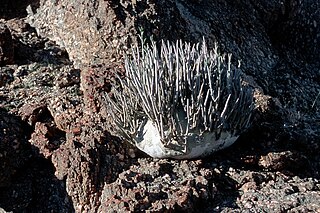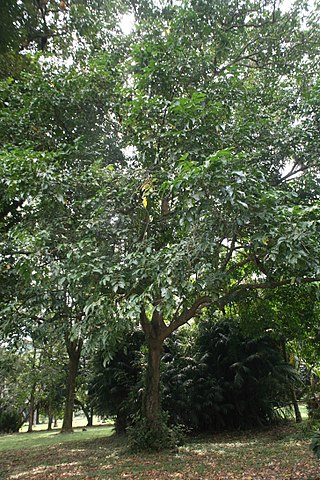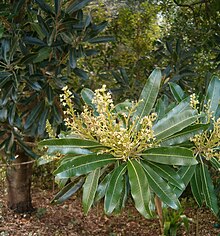
Sapindales is an order of flowering plants. Well-known members of Sapindales include citrus; maples, horse-chestnuts, lychees and rambutans; mangos and cashews; frankincense and myrrh; mahogany and neem.

The Anacardiaceae, commonly known as the cashew family or sumac family, are a family of flowering plants, including about 83 genera with about 860 known species. Members of the Anacardiaceae bear fruits that are drupes and in some cases produce urushiol, an irritant. The Anacardiaceae include numerous genera, several of which are economically important, notably cashew, mango, Chinese lacquer tree, yellow mombin, Peruvian pepper, poison ivy, poison oak, sumac, smoke tree, marula and cuachalalate. The genus Pistacia is now included, but was previously placed in its own family, the Pistaciaceae.

Toxicodendron is a genus of flowering plants in the sumac family, Anacardiaceae. It contains trees, shrubs and woody vines, including poison ivy, poison oak, and the lacquer tree. All members of the genus produce the skin-irritating oil urushiol, which can cause a severe allergic reaction. The generic name is derived from the Greek words τοξικός (toxikos), meaning "poison," and δένδρον (dendron), meaning "tree". The best known members of the genus in North America are poison ivy (T. radicans), practically ubiquitous throughout most of eastern North America, and western poison oak, similarly ubiquitous throughout much of the western part of the continent.

Sumac or sumach is any of about 35 species of flowering plants in the genus Rhus and related genera in the cashew family (Anacardiaceae). Sumacs grow in subtropical and temperate regions throughout every continent except Antarctica and South America. Sumac is used as a spice, as a dye, and in medicine.

Zanthoxylum is a genus of about 250 species of deciduous and evergreen trees, shrubs and climbers in the family Rutaceae that are native to warm temperate and subtropical areas worldwide. It is the type genus of the tribe Zanthoxyleae in the subfamily Rutoideae. Several of the species have yellow heartwood, to which their generic name alludes. Several species are cultivated for their use as spices, notably including Sichuan pepper.

Adenia is a genus of flowering plants in the passionflower family Passifloraceae. It is distributed in the Old World tropics and subtropics. The centers of diversity are in Madagascar, eastern and western tropical Africa, and Southeast Asia. The genus name Adenia comes from "aden", reported as the Arabic name for the plant by Peter Forsskål, the author of the genus.

Louis-Marie Aubert du Petit-Thouars was an eminent French botanist known for his work collecting and describing orchids from the three islands of Madagascar, Mauritius and Réunion. The standard author abbreviation Thouars is used to indicate this person as the author when citing a botanical name.

The genus of the myrrhs, Commiphora, is the most species-rich genus of flowering plants in the frankincense and myrrh family, Burseraceae. The genus contains approximately 190 species of shrubs and trees, which are distributed throughout the (sub-) tropical regions of Africa, the western Indian Ocean islands, the Arabian Peninsula, India, and South America. The genus is drought-tolerant and common throughout the xerophytic scrub, seasonally dry tropical forests, and woodlands of these regions.

Astronium is a genus of flowering plants in the cashew family, Anacardiaceae. It is native to Central and South America.

Nesogordonia is a genus of flowering plants. It ranges across tropical Africa, Madagascar, and the Comoro Islands. The majority of species are endemic to Madagascar.

Euroschinus is a genus of plant in family Anacardiaceae.

Noronhia is a genus of 40 known species of flowering plants in the family Oleaceae, all but one native to Madagascar, the remaining species native to the Comoros Islands north of Madagascar. A few have become naturalized in Mauritius, Réunion, and Bermuda.

Poupartia is a genus of plant in family Anacardiaceae. From the islands of Madagascar, Mauritius, Rodrigues and Réunion, all in the Indian Ocean.

Sorindeia is a genus of flowering plants in the cashew family, Anacardiaceae. It includes ten species native to tropical Africa, Madagascar, and the Comoro Islands. They are distinguished by their compound leaves, large inflorescences and distinctive fruit. In the case of S. madagascariensis, as many as 200 fruit may be carried on a pendant cluster.

Anacardioideae is a subfamily of plants in the family Anacardiaceae.

Fegimanra is a small genus of trees in the subfamily Anacardioideae of the cashew and sumac family Anacardiaceae. They grow naturally in west and west-central tropical Africa.
Faguetia is a monotypic genus of trees in the subfamily Anacardioideae of the cashew and sumac family Anacardiaceae. It contains the single species Faguetia falcata, which is endemic to eastern Madagascar.

Pseudospondias is a genus of plants in the subfamily Spondiadoideae of the cashew and sumac family Anacardiaceae. They grow as dioecious shrubs or trees and are found in forests of Sub-Saharan Africa.
Poupartiopsis is a monotypic genus of flowering plants belonging to the family Anacardiaceae. The only species is Poupartiopsis spondiocarpus.
Micronychia is a genus of flowering plants in the family Anacardiaceae, with all species endemic to Madagascar, usually on the eastern side of the island.

















